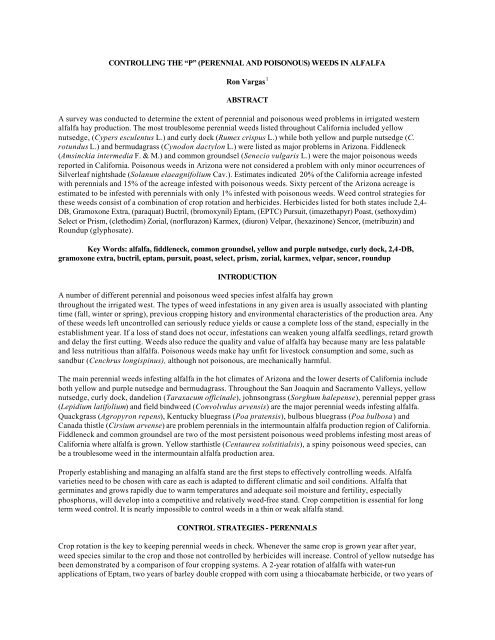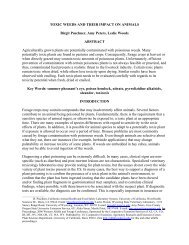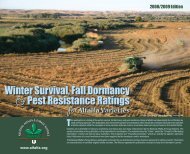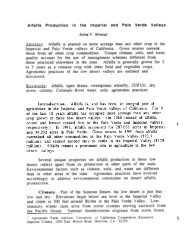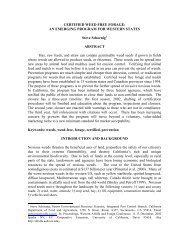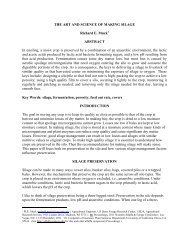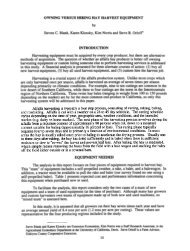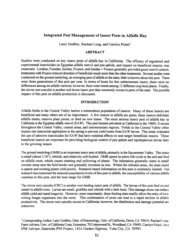CONTROLLING THE âPâ (PERENNIAL AND POISONOUS) WEEDS ...
CONTROLLING THE âPâ (PERENNIAL AND POISONOUS) WEEDS ...
CONTROLLING THE âPâ (PERENNIAL AND POISONOUS) WEEDS ...
Create successful ePaper yourself
Turn your PDF publications into a flip-book with our unique Google optimized e-Paper software.
<strong>CONTROLLING</strong> <strong>THE</strong> “P” (<strong>PERENNIAL</strong> <strong>AND</strong> <strong>POISONOUS</strong>) <strong>WEEDS</strong> IN ALFALFA<br />
Ron Vargas 1<br />
ABSTRACT<br />
A survey was conducted to determine the extent of perennial and poisonous weed problems in irrigated western<br />
alfalfa hay production. The most troublesome perennial weeds listed throughout California included yellow<br />
nutsedge, (Cypers esculentus L.) and curly dock (Rumex crispus L.) while both yellow and purple nutsedge (C.<br />
rotundus L.) and bermudagrass (Cynodon dactylon L.) were listed as major problems in Arizona. Fiddleneck<br />
(Amsinckia intermedia F. & M.) and common groundsel (Senecio vulgaris L.) were the major poisonous weeds<br />
reported in California. Poisonous weeds in Arizona were not considered a problem with only minor occurrences of<br />
Silverleaf nightshade (Solanum elaeagnifolium Cav.). Estimates indicated 20% of the California acreage infested<br />
with perennials and 15% of the acreage infested with poisonous weeds. Sixty percent of the Arizona acreage is<br />
estimated to be infested with perennials with only 1% infested with poisonous weeds. Weed control strategies for<br />
these weeds consist of a combination of crop rotation and herbicides. Herbicides listed for both states include 2,4-<br />
DB, Gramoxone Extra, (paraquat) Buctril, (bromoxynil) Eptam, (EPTC) Pursuit, (imazethapyr) Poast, (sethoxydim)<br />
Select or Prism, (clethodim) Zorial, (norflurazon) Karmex, (diuron) Velpar, (hexazinone) Sencor, (metribuzin) and<br />
Roundup (glyphosate).<br />
Key Words: alfalfa, fiddleneck, common groundsel, yellow and purple nutsedge, curly dock, 2,4-DB,<br />
gramoxone extra, buctril, eptam, pursuit, poast, select, prism, zorial, karmex, velpar, sencor, roundup<br />
INTRODUCTION<br />
A number of different perennial and poisonous weed species infest alfalfa hay grown<br />
throughout the irrigated west. The types of weed infestations in any given area is usually associated with planting<br />
time (fall, winter or spring), previous cropping history and environmental characteristics of the production area. Any<br />
of these weeds left uncontrolled can seriously reduce yields or cause a complete loss of the stand, especially in the<br />
establishment year. If a loss of stand does not occur, infestations can weaken young alfalfa seedlings, retard growth<br />
and delay the first cutting. Weeds also reduce the quality and value of alfalfa hay because many are less palatable<br />
and less nutritious than alfalfa. Poisonous weeds make hay unfit for livestock consumption and some, such as<br />
sandbur (Cenchrus longispinus), although not poisonous, are mechanically harmful.<br />
The main perennial weeds infesting alfalfa in the hot climates of Arizona and the lower deserts of California include<br />
both yellow and purple nutsedge and bermudagrass. Throughout the San Joaquin and Sacramento Valleys, yellow<br />
nutsedge, curly dock, dandelion (Taraxacum officinale), johnsongrass (Sorghum halepense), perennial pepper grass<br />
(Lepidium latifolium) and field bindweed (Convolvulus arvensis) are the major perennial weeds infesting alfalfa.<br />
Quackgrass (Agropyron repens), Kentucky bluegrass (Poa pratensis), bulbous bluegrass (Poa bulbosa) and<br />
Canada thistle (Cirsium arvense) are problem perennials in the intermountain alfalfa production region of California.<br />
Fiddleneck and common groundsel are two of the most persistent poisonous weed problems infesting most areas of<br />
California where alfalfa is grown. Yellow starthistle (Centaurea solstitialsis), a spiny poisonous weed species, can<br />
be a troublesome weed in the intermountain alfalfa production area.<br />
Properly establishing and managing an alfalfa stand are the first steps to effectively controlling weeds. Alfalfa<br />
varieties need to be chosen with care as each is adapted to different climatic and soil conditions. Alfalfa that<br />
germinates and grows rapidly due to warm temperatures and adequate soil moisture and fertility, especially<br />
phosphorus, will develop into a competitive and relatively weed-free stand. Crop competition is essential for long<br />
term weed control. It is nearly impossible to control weeds in a thin or weak alfalfa stand.<br />
CONTROL STRATEGIES - <strong>PERENNIAL</strong>S<br />
Crop rotation is the key to keeping perennial weeds in check. Whenever the same crop is grown year after year,<br />
weed species similar to the crop and those not controlled by herbicides will increase. Control of yellow nutsedge has<br />
been demonstrated by a comparison of four cropping systems. A 2-year rotation of alfalfa with water-run<br />
applications of Eptam, two years of barley double cropped with corn using a thiocabamate herbicide, or two years of
arley followed by fallow with Roundup all reduced the viable nutsedge tubers by 96 to 98 percent when compared<br />
to a continuous cotton rotation.<br />
Perennial weed problems are most often a problem in established alfalfa and can further reduce the vigor and growth<br />
of an already weakened alfalfa stand. Control programs and herbicide selection is dependent upon the perennial<br />
weed present.<br />
Nutsedge. Yellow and purple nutsedge can be a serious problem, especially where alfalfa is grown in sandy soils. If<br />
residual and/or selective grass herbicides have been used, reducing summer grasses, many times nutsedge<br />
populations will increase due to the lack of competition from other weeds. Most soil applied, residual herbicides<br />
(Karmex, Velpar, and Sencor) and the selective grass herbicides (Poast and Prism) do not control nutsedge.<br />
Control or suppression of nutsedge can be accomplished with water run Eptam and Zorial. Eptam should be applied<br />
before nutsedge emergence with sequential applications needed for season long suppression. The first application<br />
should be at 3 pounds ai/A with later applications at 2 pounds ai/A. A maximum of 12 pounds can be used per<br />
season and grazing or harvest cannot occur within 14 days of application.<br />
Zorial applications may be made to both dormant and actively growing alfalfa, but for best suppression of nutsedge,<br />
early applications when alfalfa is dormant is best. Nutsedge growth is suppressed and may further be reduced if used<br />
for two growing seasons. Consideration must be given to rotational crops as up to 16 months after application the<br />
only crop that can be planted is cotton. Corn is extremely sensitive to Zorial with severe injury occurring if planted<br />
too soon after application.<br />
The use of Eptam during the fallow summer season can suppress the growth of both yellow and purple nutsedge.<br />
Apply Eptam to a pre-irrigated field in June or July and incorporate by cross discing with a heavy drag bar to seal<br />
the soil surface. Leave the soil undisturbed for at least 60 days. Nutsedge escapes can be treated with Roundup.<br />
Johnsongrass. Johnsongrass can be a problem in seedling alfalfa, but it is most troublesome in established alfalfa.<br />
Johnsongrass growth from rhizomes is not controlled with any of the residual herbicides that can be used in<br />
established alfalfa. Prism and Poast will provide acceptable control if applied when the grass is 12 to 18 inches tall.<br />
Usually two to three treatments are necessary to provide effective control and reduction of next season’s growth.<br />
Field Bindweed. Field bindweed is best controlled before planting alfalfa or in rotational crops. Control or<br />
suppression can be achieved in small grains with the use of broadleaf herbicides or with Roundup applied to a<br />
Roundup Ready transgenic herbicide tolerant cotton variety. Control of bindweed can also be addressed in a fallow<br />
system with intensive tillage and the use of Roundup and/or a phenoxy herbicide.<br />
Bermudagrass. Bermudagrass is normally a problem at the ends of the field where standing water has reduced the<br />
alfalfa stand. Some control of seedlings may be provided with preplant treatments of Balan or Eptam, but in<br />
established alfalfa repeated applications of Poast or Prism will provide effective control.<br />
Curly Dock. Curly dock, also referred to as sour dock can be a problem in both seedling and established alfalfa<br />
especially in low areas of the field or at ends of the field that tend to collect water and stay moist for extended<br />
periods of time. Once established, soil residual herbicides have no effect in control of this perennial. Mick Canevari,<br />
Farm Advisor in San Joaquin County, has demonstrated effective control with fall applications of 2,4-DB (Butyrac)<br />
alone or in combination with Pursuit. Pursuit applied alone did not provide acceptable control. Spring applications<br />
provided 20 to 45 percent less control than the fall applications.<br />
Dandelion. Dandelion is a perennial herb with milky juices in the stem causing the plants to turn black during<br />
curing. The black color detracts from the appearance of the alfalfa’s green color reducing it’s value. Control of<br />
dandelion with existing alfalfa herbicides is difficult. Soil residual herbicides do not provide effective control. When<br />
in the seedling stage 2,4-DB will provide partial control. Control can be achieved with Roundup when applied<br />
during fallow periods between crops. In a study conducted by Steve Orloff, Farm Advisor, Siskiyou County, the<br />
imidazolinone herbicides Pursuit and Raptor provided the best control (40 to 72%) and showed the most promise,
causing very little alfalfa injury and fair dandelion suppression. The standard soil residual herbicides, Velpar, Sencor<br />
and Zorial did not provide effective control.<br />
CONTROL STRATEGIES - <strong>POISONOUS</strong> <strong>WEEDS</strong><br />
Several weed species encountered in alfalfa are poisonous to livestock including fiddleneck, common groundsel,<br />
cocklebur, jimsonweed, scarlet pimpernel, starthistle, tansy ragwort and<br />
waterhemlock. But, fiddleneck and common groundsel are the most common and dangerous to livestock.<br />
Rarely do either fiddleneck or common groundsel occur as the only weed problem, but normally they will be<br />
associated with other winter annuals consisting of london rocket, shepherds purse, annual bluegrass and chickweed.<br />
Winter weeds may be a problem even in the best managed fields, however, managing cultural practices in such a<br />
way as to produce a healthy, vigorous stand of alfalfa will enhance competition with weeds and reduce the problem.<br />
Consideration also needs to be given to other pests, as weakened stands due to insect pressure or disease do not grow<br />
as fast or have as dense a leafy canopy; therefore, its ability to compete with weeds is reduced.<br />
Fiddleneck and common groundsel are usually less of a problem in early fall plantings (September and October)<br />
than winter or spring. With proper seedbed preparation, pre-irrigation, fertilization, and seeding rates, fall planted<br />
stands will grow vigorously and effectively competing with winter weeds. Late winter and spring plantings usually<br />
grow slower due to cold and freezing winter temperatures making the stand much less competitive with winter<br />
weeds, especially fiddleneck.<br />
Control methods of fiddleneck and common groundsel will vary somewhat as fiddleneck is normally a problem in<br />
first year seedling hay with common groundsel being a problem in established as well as seedling hay. Because<br />
these weeds normally occur in mixed stands identification and records of infested fields, are essential to developing<br />
effective weed management strategies. When considering the use of herbicides for control of these weeds, the<br />
discussion needs to be divided into seedling and established stands of hay.<br />
SEEDLING ALFALFA<br />
Of the two weed species in question, fiddleneck is normally only a problem through the first cutting in seedling hay.<br />
Seldom does it occur after the first cutting or in established stands. Control can be achieved with either the use of a<br />
pre or post emergence herbicide or a combination of the two. Fiddleneck infestations can be partially controlled with<br />
Eptam or Balan when applied prior to planting as a preplant incorporated treatment. Eptam can also be applied water<br />
run or through sprinklers. As with most herbicides, these two chemicals do not control other common occurring<br />
winter annuals such as black mustard and london rocket. Common groundsel will not be controlled by Balan and<br />
only partial control can be expected with Eptam. Roundup can be applied anytime before planting. Effective control<br />
can be achieved when Roundup is applied at 0.5 lb. ai/A to fiddleneck in the 4 to 6 inch rosette stage.<br />
Timing is the key to the effective control of fiddleneck and common groundsel with the postemergence herbicides<br />
2,4-DB, Gramoxone Extra, Buctril and Pursuit. Applications need to be made when the weeds are young seedlings,<br />
having only 2 to 3 true leaves. When the seedlings reach the rosette stage control becomes erratic and unsuccessful.<br />
But, because the postemergence herbicides can only be used on alfalfa with a minimum of 2 to 3 trifoliate leaves<br />
ideal timing of herbicide application for effective control may not be possible. Many times the fiddleneck and<br />
common groundsel will be beyond the rosette stage before the alfalfa is mature enough to be treated.<br />
Buctril provides effective control of fiddleneck, but only partial control of common groundsel. Pursuit applied to<br />
alfalfa in the second trifoliate leaf stage or larger when weeds are 1 to 3 inches in size will provide partial control of<br />
both fiddleneck and common groundsel. Gramoxone will provide partial control of both weed species when applied<br />
to alfalfa with 3 to 9 trifoliate leaves and weeds are under 6 to 8 inches tall. Rates vary with crop size. At 3 trifoliate<br />
leaves, 6.5 oz, 3 to 6 trifoliate leaves, 13 oz and 6 to 9 trifoliate leaves, over 13 oz of Gramoxone can be applied.<br />
Often weeds are beyond the stage for effective control before the alfalfa reaches 3 trifoliate leaves to allow the safe<br />
use of Gramoxone. Even then alfalfa leaf burn can occur, but recovery usually occurs. Neither fiddleneck or<br />
common groundsel are effectively controlled with 2,4-DB.
ESTABLISHED ALFALFA HAY<br />
Fiddleneck infestations are normally not found in established alfalfa hay fields having a good stand. Although, it can<br />
invade established stands that are weak and have open areas in the alfalfa stand. Common groundsel, along with<br />
other winter annuals such as chickweed, shepherds purse and london rocket are much more prevalent and normally a<br />
persistent problem. As with fiddleneck, common groundsel usually only exists during the first cutting and in some<br />
cases may carry over to the second cutting.<br />
Preemergence herbicides can be applied alone or in combination with a postemergence herbicide during the dormant<br />
season. Karmex, Velpar, Sencor and Zorial are all available for control of winter annual weeds including fiddleneck<br />
and common groundsel.<br />
Karmex should be applied after dormancy begins up through January, but before weeds are well established.<br />
Karmex will not control common groundsel. Only one year or older stands should be treated, but due to plant back<br />
restriction Karmex should not be used in the last year of the stand. Karmex should not be used on coarse soils or in<br />
areas where the alfalfa does not go dormant.<br />
Velpar should be applied only when the alfalfa is dormant. Best control of common groundsel is achieved with<br />
Velpar. It can be applied to alfalfa less than one year old, but no more than 0.675 lb ai/A. Velpar cannot be used in<br />
low desert valleys or at high rates in high rainfall areas. Velpar should not be used in the last year of the alfalfa stand<br />
due to rotational crop restrictions.<br />
Sencor should be applied when alfalfa is dormant. Only one year or older stands should be treated. Sencor will only<br />
provide partial control of common groundsel. Its use is restricted north of Interstate 80 and cannot be applied more<br />
than 1 lb. ai/A/season. Plant back restrictions need to be observed.<br />
Zorial applied during dormant period will only provide partial control of fiddleneck and common groundsel. Lower<br />
rates should be used in coarse textured soils. Zorial is only recommended for established alfalfa and cannot be<br />
applied seedling alfalfa earlier than five months following emergence. For 16 months after the last application of<br />
Zorial, fields may only be rotated to cotton.<br />
Even though Karmex, Velpar and Sencor have some postemergence activity on small weed seedlings Gramoxone<br />
Extra is often applied in combinations with the preemergence herbicides to enhance control of existing weed<br />
seedlings. Gramoxone Extra will provide partial control of both common groundsel and fiddleneck in the last year of<br />
an alfalfa stand when none of the residual herbicides can be used. It has to be applied during the dormant period and<br />
cannot be applied if fall regrowth following the last cuttings is greater than 6 inches, or if spring regrowth is more<br />
than 2 inches. The alfalfa cannot be harvested grazed within 42 days of application.<br />
CONCLUSION<br />
A number of different perennial and poisonous weeds infest alfalfa hay throughout the irrigated west. If left<br />
uncontrolled these weeds can seriously reduce yield or cause a loss of stand in the establishment year. Weeds also<br />
reduce quality, which reduces the value, and poisonous weeds make alfalfa unfit for livestock consumption.<br />
Effective control of both perennial and poisonous weeds begins with properly establishing and managing alfalfa as a<br />
vigorously growing competitive stand. Perennials weeds are best kept under control with crop rotations, where<br />
cultural practices and herbicides allow effective control options. A number of preemergence and post emergence<br />
herbicides are available for control of weeds in both seedling and established stands of alfalfa. When crop rotations,<br />
establishing and maintaining a healthy competitive alfalfa stand and herbicides are used in an integrated program,<br />
weeds are effectively controlled in both seedling and established alfalfa stands.
Table 1 - Time of application and method of activity for herbicides used in alfalfa.<br />
CROP STAGE TIME OF HERBICIDE APPLICATION HERBICIDE ACTIVITY<br />
Herbicide<br />
Seedling<br />
Alfalfa<br />
Established<br />
Alfalfa<br />
Preplant<br />
Before Weed<br />
Emergence<br />
After Weed<br />
Emergence<br />
Soil Active<br />
Foliar<br />
Active<br />
Eptam (EPTC) Yes Yes Yes Yes No Yes No<br />
Balan (benefin) Yes No Yes Yes No Yes No<br />
Butyrac, Butoxone<br />
(2,4-DB) Yes Yes No No Yes No Yes<br />
Buctril (bromoxynil) Yes No No No Yes No Yes<br />
Prism (clethodim) Yes Yes No No Yes No Yes<br />
Poast (sethoxydim) Yes Yes No No Yes No Yes<br />
Pursuit (imazethapyr) Yes Yes No No Yes Yes Yes<br />
Kerb (pronamide) Yes Yes No Yes Yes Yes No<br />
Gramoxone Extra (paraquat) Yes Yes Yes No Yes No Yes<br />
Velpar (hexazinone) Yes 1 Yes No Yes Yes Yes Some<br />
Karmex, Direx (diuron) No Yes No Yes Some Yes Slight<br />
Sencor, Lexone (metribuzin) No Yes No Yes Yes Yes Some<br />
Treflan (trifluralin) No Yes No Yes No Yes No<br />
Zorial (norflurazoon) No Yes No Yes No Yes No<br />
1. California registration only
Table 2 - Susceptibility of Weeds to Herbicide Control<br />
<strong>POISONOUS</strong> <strong>WEEDS</strong><br />
BEN BRO DIU EPT PAR* PRO* MET SET TRI 1 HEX GLY 24D* IMA CLE NOR<br />
Fiddleneck C C C P P C C N C C C N P N P<br />
Groundsel,<br />
common N P N P P N P N N C C N P N N<br />
Starthistle,<br />
yellow P P C C P N - N N C C C N N N<br />
<strong>PERENNIAL</strong>S <strong>WEEDS</strong><br />
barley, foxtail P N P P P C C C P P C N N C C<br />
bermudagrass P N N P N N N P N N C N N P P<br />
bindweed,<br />
field N N - N N - - N P - P - N N N<br />
dandelion N N - - P N P N N P C C 2 N N -<br />
johnsongrass<br />
(seedling) P N C C - C N C - C C - C C C<br />
nutsedge,<br />
yellow N N N P N N P N N N P N P N P<br />
plaintain,<br />
buckhorn N N N - P - - N N N P C 2 N N P<br />
quackgrass - N P P N C - P N P C N P - -<br />
BEN = benefin (Balan) TRI = trfluralin 1 (Treflan, Trilin)<br />
BRO = bromoxynil (Buctril)<br />
HEX = hexazinone (Velpar)<br />
DIU = diuron, (Karmex, Direx) GLY = glyphosate (Roundup)<br />
EPT = EPTC (Eptam) 24D = 2,4-DB* (Butoxone, Butyrac)<br />
PAR = paraquat* (Gramoxone Extra) IMA = imazehapyr (Pursuit) (highest rate)<br />
PRO = pronamide* (Kerb) CLE = clethodim (Prism)<br />
MET = metribuzin (Lexone, Sencor) NOR = norflurzon (Zorial)<br />
SET = sethoxydim (Poast)<br />
C = control<br />
P = partial control<br />
N = no control<br />
- = no information<br />
1 Paraquat is not usually applied when summer weeds are emerged.<br />
2<br />
Control only in seedling stage<br />
* Permit required from county agricultural commissioner for purchase or use.


